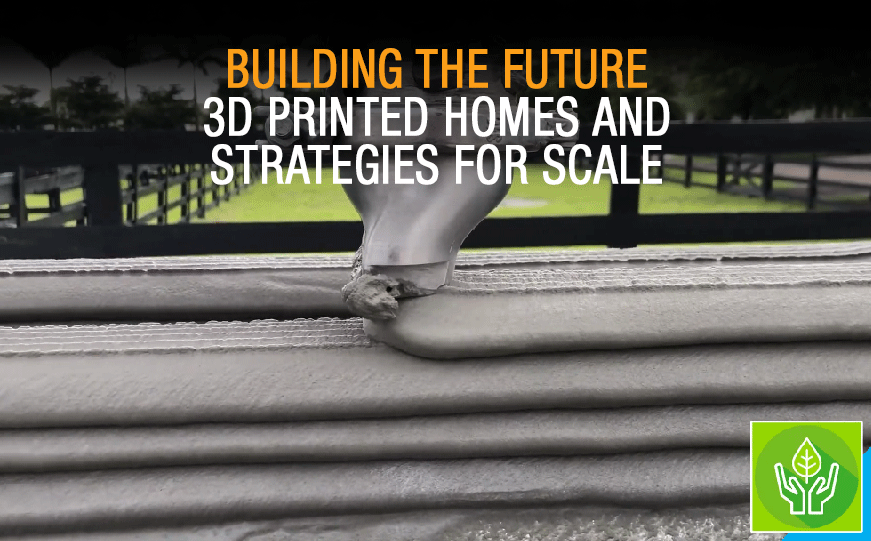Photo captured from the video, LATICRETE Brand Promises, posted to YouTube November 15, 2022
“LATICRETE’s intention is to bring our products – our technology – to everyone in the world. To help build better, greener, safer buildings.”
David A. Rothberg
Chairman of the Board
Steve Kleber, founder of integrated marketing communications firm Kleber & Associates, and I recently discussed the growing momentum — and opportunities — for 3D printed homes and how they will impact the building industry.
~ Chris Luzar, Frohman & Associates
3D printing for new home construction continues to command headlines. And two primary factors are driving this attention:
- The technology’s potential to help alleviate a portion of the U.S. housing challenge to deliver affordable units. Just consider the June 2023, report from the Joint Center for Housing Studies highlighting a housing shortage of at least 1.5 million units. Estimates are for 21.6 million renters and 19 million homeowners to spend over 30% of income on housing… pricing many out of homeownership.
- 3D printing technology is projected to be faster, requiring less labor — while producing less waste — than traditional construction. Which is particularly appealing to builders… at a time of worker shortages and rising material costs.
The gains presented by 3D printing are significant; however, achieving its envisioned affordability, sustainability and production efficiency (at scale) is still considered a work-in-progress.
In fact, use in new home construction remains so novel… that guidelines on how to build safely were only recently published two months ago in December. ISO/ASTM 52939 identifies the quality-assurance requirements for construction projects built with 3D printing techniques.
Scaling 3D Printing: Innovators Advance
Despite the obstacles, innovators in 3D printing are moving beyond proof-of-concepts projects — or small-scale builds — and marketing to home builders. Each of these Innovators deploys a different business model to scale the 3D printed home building process:
Mighty Buildings
- Includes factory-printed, insulated wall panels with a proprietary concrete-free formula, structural steel frames and hardware… delivered direct to construction sites.
In collaboration with Lawrence Berkeley National Laboratory and Habitat for Humanity, Mighty Buildings was awarded a significant grant to build 3D printed homes in a San Francisco Bay Area project backed by the CA Energy Commission.
Black Buffalo 3D
PAAS — Printing as a System
- Features a comprehensive service model integrating a NEXCON™ printer — with proprietary 3D “ink” — and optional team deployment to 3D print structures in the field.
Two homes in Newport News printed with NEXCON printers and Planitop 3D ink are using printed beads as the load-bearing component of the homes.
- Franchises the Alquist 3D Printing Eco System including robots, “ink” and process know-how.
- Printing residential homes in uncontrolled environments, helping to position 3D printing technology as complementary to stick-build, while offering new design possibilities.
- Alternately, printing infrastructure — or builder products — in a controlled environment… producing standalone elements such as curb systems. Even oyster beds and urns.
A partnership with Aims Community College has established a $26 million R&D and a training hub to leverage resources for the 3-D-printed construction industry.
Sells a triad of robots “who” have been named as follows:
- Mary – Portable silo for proprietary geoploymer “ink”
- Gary – Brain of the system that optimizes composition of dry material, water requirements and mix time
- Frank – Printing robot with POLARTM patented robotic arm design
Apis Cor is building model homes with community developer partnerships — scaling the system and bringing “the factory” to the build site — as a full process implementation to demonstrate much more than a proof of concept.
The Promise and Progress of 3-D-Printed Homes
While innovators adopt varied strategies, collectively, they emphasize that technology development alone won’t drive scalability. Innovators have identified three additional requisite catalysts to achieve scale:
On The Job Impact
Proponents claim that 3D printing does not pose a threat to existing jobs. Instead they argue, the technology promotes safer and more efficient building practices.
Attracting Entry Level Talent
Robotics — and the opportunity for training in new technology — contrast traditional labor-intensive tasks. The model is designed to attract less experienced talent into the construction industry. The choice between programming a robot — and driving a nail — is compelling. The potential is targeted to reverse the current attrition rates… for every seven people leaving the industry, only one new person joins.
Design Possibilities
3D printing offers significant, new design possibilities. Opening up innovative applications for installed building products. And improving energy efficiency — by impeding heat transfer — increasing insulation and establishing an even tighter building envelope.
Yes, it is clear that the adoption of 3D printing in home building is not merely a technological shift. Rather, it is a strategic move to reshape the industry. Addressing skill development. Attracting new talent. And most importantly, unlocking creative design potential.
As in every business strategy, staying ahead requires awareness of evolving practices. If you’d like to explore how content marketing, thought leadership and e-newsletter campaigns — like this one — can enhance your own innovative brand promise, let’s connect at sk@kleberandassociates.com to get the conversation started.




